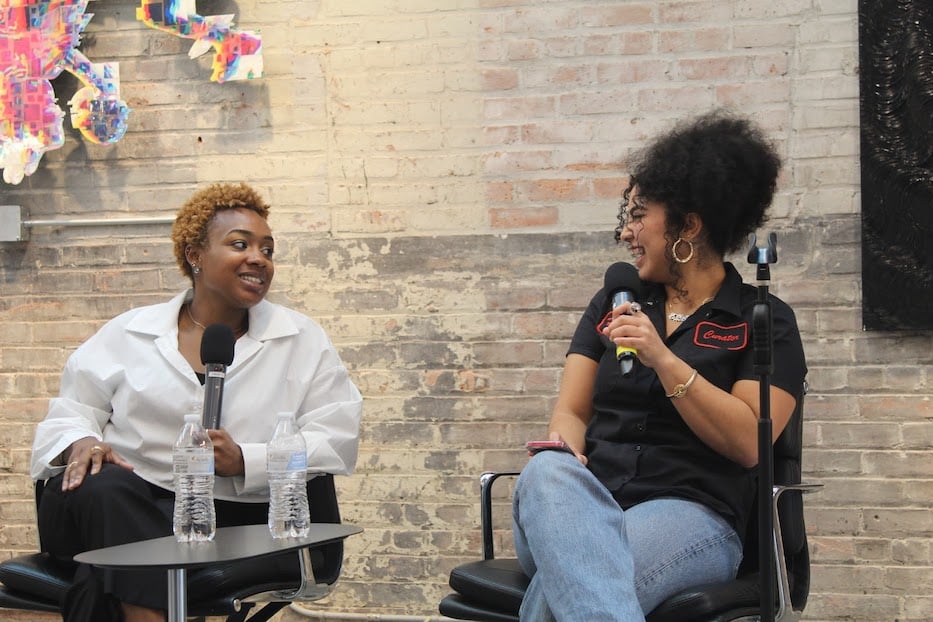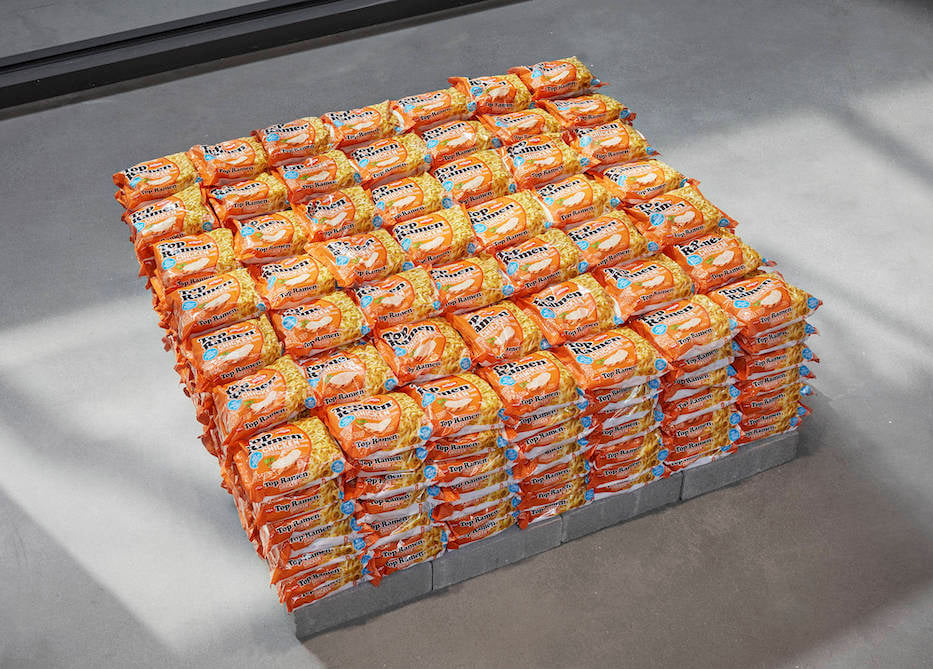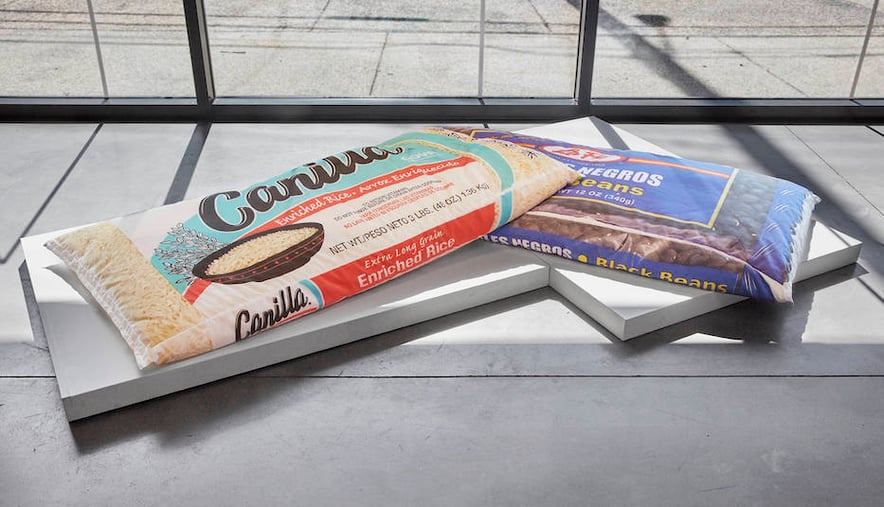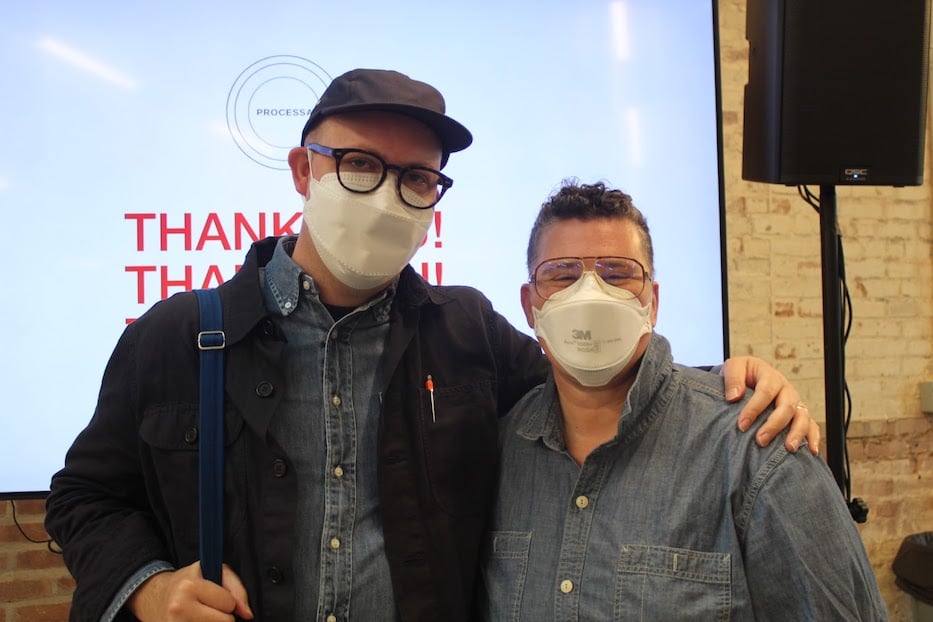
Curatorial fellows Cornelia Stokes and Kiara Cristina Ventura. Abiba Biao Photo.
In 1917, the French artist Marcel Duchamp presented a urinal to feature in the Society of Independent Artists’ salon in New York. The group claimed that they would accept any work of art, as long as the artist paid the application fee. Despite him signing his urinal under a fake name and dating his work, his submission was rejected.
It prompted a question that remains unanswered: What makes something a work of art?
Curatorial fellows Cornelia Stokes and Kiara Cristina Ventura set out to answer that question Saturday at NXTHVN, in a pop-up art history class titled “By Any Means Necessary: Collected Objects as Art Material.” Saturday and Sunday, it was part of a weekend-long celebration at the 169 Henry St. incubator that included open studios, art history classes, family-friendly crafting, and an afternoon scavenger hunt.
“These programs are created for people who are interested in being in the creative space,” Stokes said. “And so come, ask questions, you know, get to know folks because these [people] are also in the art world.”

Sable Elyse Smith's Spread (2018) in Not For Sale at NXTHVN. Chris Gardner Photo.
Saturday, the jumping off point was Not For Sale, of which Stokes and Ventura are the curators. The exhibition focuses on using everyday objects in Black and Brown communities as high art and runs until May 14. Read more about it in the Arts Paper here.
Saturday's presentation addressed prominent contemporary artists who have used found objects in their own work. In curating the show, Stokes and Ventura were especially inspired by artists David Hammons, Betye Irene Saar, and Theaster Gates. For these artists, found objects build off of the concept of the “readymade,” a term coined by Duchamp in 1916. It refers to artworks and installations made from common objects that aren’t typically seen as fine art materials.
Found objects are used extensively in the exhibition Not For Sale. In Sable Elyse Smith's Spread (2018), for instance, packs of Top Ramen chicken-flavored noodles are stacked in a square on top of cement bricks. In Hammons’ work Untitled, the piece features six clear wine bottles, each filled with an assortment of materials such as fish, roses, and a cardboard lightning bolt.
“All the artists in the show use found objects within their work, to speak about culture, race, identity class,” Ventura said. “And we also wanted to talk about accessibility within the work. All [of] the mediums are low cost.”
Throughout the presentation, Ventura and Stokes also paused briefly for “Oh Word!”a short segment to define pieces of art vocabulary and terms.

Lucia Hierro's Arroz Blanco and Frijoles Negro (both 2020) in Not For Sale at NXTHVN. Chris Gardner Photos.
In a later portion of the class, the two pointed to the work of Félix González-Torres as especially influential to their practice and understanding. A Cuban American artist, González-Torres used his work to bring attention to the AIDS epidemic in the 1990s. In pieces like his Perfect Lovers, twin clocks represent the relationship between him and his partner Ross Laycock. Laycock, who was also diagnosed with AIDS, died in 1991, six years prior to González-Torres' own death in 1996.
González-Torres often used something called “relational aesthetics,” in which artists could be facilitators as well as makers. In his 1991 piece Untitled (Placebo), for instance, he had spectators interact with his “candy spills"—oceans of cellophane-wrapped hard candy at which viewers could pick away. The piece was most recently on display at the Museum of Modern Art (MoMA) in the early 2000s.
“Visitors are invited to take a candy with them and eat it,” Ventura said “So the visitors are actually a part of the work with every installation. And that's what makes it also conceptual; without the audience there is no work.”
The relational aesthetic with the audience leads to the slow disappearance of the sculpture over the course of the exhibition, she added. It uses a common item like candy to show how victims of the AIDS epidemic are disposed of and how casualties are seen as insignificant.

James Goggin and Lisi Raskin. Abiba Biao Photo.
Afterwards, attendees agreed that the class was a hit. Artists James Goggin and Lisi Raskin didn’t plan to sit in an hour-long presentation, but said they were delightfully pleased by their redirection. Goggin is a London-born graphic designer who runs his own graphic design firm called Practise. He used to live in Providence, teaching graphic design at the Rhode Island School of Design (RISD) but now lives in Auckland, New Zealand.
He worked with NXTHVN founder and president Titus Kaphar and lawyer, poet and literacy champion Reginald Dwayne Betts to design their book Redaction, published earlier this year, about injustices in the criminal justice system. He’s always looked at NXTHVN from afar, he said, and was not only there on business but to finally meet his coworkers face to face.
“This is my first time finally visiting NXTHVN in person and quite possibly, I'll be seeing them in person for the first time this afternoon after many years on Zoom,” he said.
Goggin said that his interest to explore NXTHVN is to see how art can expand and serve communities instead of “being rarified and kind of isolated in lofty institutions.” He connected his experience with Yale and New Haven to his teaching and working in Providence, where Brown University is located. In both places, high "art" is segregated to sites with large endowments.
“I've really been interested in NXTHVN, particularly in a divided town like New Haven, with Yale looming large and having lived in Providence, where obviously Brown and RISD similarly occupy those kinds of slightly detached spaces,” he said.
Similar to Goggin, Raskin has been admiring NXTHVN from afar following the work of Jeffery Meris, a previous studio fellow in 2020. They liked how the talk contextualized contemporary studio artists with historical artists linking themes and trends together, they said.
Raskin said that they liked how NXTHVN “tuned in to the needs of the immediate community,” by increasing accessibility to art and said that they would take their “Oh Word!” segments and credit them to use with their own students.
“Art by design is exclusive and elite, so if you're having a feeling that you don't belong there, they set it up to feel that way,” Raskin said. “So if it doesn't feel that way, and people are like, super welcoming to you in an art space, that's really special.”
Stokes and Ventura are coordinating another upcoming exhibition, which will feature the fourth cohort of NXTHVN's fellows, opening June 29 at Sean Kelly Gallery in New York City. The display will feature the works of NXTHVN studio fellows Anindita Dutta, Donald Guevara, Ashanté Kindle, Athena Quispe, Edgar Serrano and Capt. James Stovall V.
Abiba Biao is a graduate of the Arts Council's Youth Arts Journalism Initiative and has stayed on with the Arts Paper as a freelance writer and photographer. She is currently a freshman at Southern Connecticut State University (SCSU).